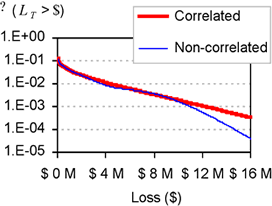
F=faculty; GS=graduate student; US=undergraduate student; PD=post-doc; I=industrial collaborator; O=other
Click on images to enlarge in a new window
The main objective of this project is to develop ways to estimate and to account for the correlation between losses in individual components. Another goal of this study is to investigate the effect of this correlation on the dispersion of the total dollar loss conditioned on a given ground motion intensity, as well as on the probability of having losses greater than a certain dollar amount. The project will also study variations of correlation as a function of ground motion intensity and the effects of this variation on loss estimates.
The project will advance PEER’s mission of quantifying seismic performance in continuous economic parameters that are directly relevant to stakeholders and that will provide improve information to facilitate making decisions regarding seismic risks. In particular, the project will permit an improved quantification of the dispersion of loss estimates. This will permit more accurate estimation of the probability of exceeding a particular dollar loss in a building.
The correlation between the economic losses in two different components is computed as a function of the correlation at three levels:
In previous years, a methodology to compute the expected annual losses was developed. Estimating damage to two main types of components used a component-based approach: drift-sensitive and acceleration-sensitive.
A major effort was devoted to develop fragility functions for different types of structural components. Fragility functions provide a probabilistic mapping between engineering demand parameters and damage states. Damage states in each component were defined on the basis of the required course of actions to restore the component to its original condition. Fragility functions were developed using the results from different experiments on various types of structural elements.
In order to reduce the uncertainty associated with certain damage states, structural fragility surfaces were developed. In a fragility surface the probability of reaching or exceeding a damage state is computed as a function of an EDP but also as a function of a new parameter, a, which incorporates observations from experimental research. Consideration of the new parameter allows for the incorporation of particular characteristics of the component such as its detailing, but also specific information about its loading.
During year 6 the loss estimation methodology was successfully applied to the Van Nuys testbed structure. In the estimation of the mean annual frequency of exceeding a certain level of dollar loss, it was primarily assumed that the losses in individual components were non-correlated. Correlation, however can have a large effect on the dispersion of losses. In the case of buildings this is particularly important because the loss is the result of many different components. If losses in individual components are positively correlated, then assuming independence could significantly underestimate the possible losses in the building.
The effects of correlation on the estimation of direct economic losses are investigated in year 7. The estimation of the correlation between the losses in individual components requires information on the correlation at three levels of uncertainty explained earlier. The correlation at the response level, EDP | IM level, is estimated based on the response history analyses performed on the building. The correlation at the damage level, DM | EDP, is mathematically modeled by categorizing components into certain groups in terms of their damageability. Meanwhile, the correlation of repair/replacement costs for given damage, DV | DM, is estimated from the correlation between different construction costs.
Figure 1 presents a comparison between the dispersion of the loss for correlated and non-correlated cases. From the figure, it can be seen that the effects of correlation on the dispersion of the loss is significant. Figure 2 presents a comparison between the building loss curve computed for correlated and non-correlated cases. Preliminary results shown in this figure suggest that the effect of correlation increases with increasing level of intensity.
 |
|
| Figure 1 Effects of correlation on the Standard deviation of the building loss curve | Figure 2 Effects of correlation on the building loss curve |
PEER investigators at Caltech are also working on loss estimation. Their approach however, relies on MonteCarlo simulation. Correlation has not been explicitly considered in that study. In the approach used in this investigation only the first and second moment of EDP and losses are required. Some research outside of PEER is being conducted to try to quantify the impact of earthquakes. Their emphasis however is at a regional effort, while emphasis on our investigation is structure specific.
In year 8 we intend to further develop loss deaggregation. This will allow the PEER methodology to deliver improved information to facilitate decision-making of stakeholders. For example loss deaggregation will permit to identify the earthquake intensities that primarily contribute to economic losses, or the type of components with large contributions. If the performance is found unacceptable loss deaggregation will permit to identify where actions can maximize its impact in loss reduction.
Not at this point. However it is expected that in the near future a significant portion of the PEER methodology will be embraced by industry, particularly as part of the ATC-58 project.
The main milestones for the project will be the development of a methodology to estimate correlation between losses to individual components of a structure and the study of the influence of such correlation on the dispersion of the total loss. The deliverables of this project will be a report containing a step-by-step description of the improved loss PEER methodology and significant contributions to the final report of the Van Nuys testbed. It is anticipated that one and possibly two journal papers will also be prepared during year 7 to disseminate PEER’s loss estimation methodology. Also two papers will be prepared to be presented at the 13th World Conference in Earthquake Engineering.